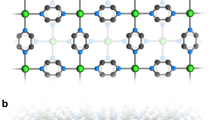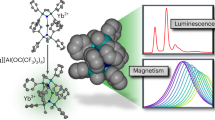Abstract
The field of molecular magnetism has grown tremendously since the discovery of single-molecule magnets, but it remains centred around the superexchange mechanism. The possibility of instead using a double-exchange mechanism (based on electron delocalization rather than Heisenberg exchange through a non-magnetic bridge) presents a tantalizing prospect for synthesizing molecules with high-spin ground states that are well isolated in energy. We now demonstrate that magnetic double exchange can be sustained by simple imidazolate bridging ligands, known to be well suited for the construction of coordination clusters and solids. A series of mixed-valence molecules of the type [(PY5Me2)VII(µ-Lbr) VIII(PY5Me2)]4+ were synthesized and their electron delocalization probed through cyclic voltammetry and spectroelectrochemistry. Magnetic susceptibility data reveal a well-isolated S = 5/2 ground state arising from double exchange for [(PY5Me2)2V2(µ-5,6-dimethylbenzimidazolate)]4+. Combined modelling of the magnetic data and spectral analysis leads to an estimate of the double-exchange parameter of B = 220 cm−1 when vibronic coupling is taken into account.
This is a preview of subscription content, access via your institution
Access options
Subscribe to this journal
Receive 12 print issues and online access
$259.00 per year
only $21.58 per issue
Buy this article
- Purchase on Springer Link
- Instant access to full article PDF
Prices may be subject to local taxes which are calculated during checkout






Similar content being viewed by others
References
Sessoli, R., Gatteschi, D., Caneschi, A. & Novak, M. A. Magnetic bistability in a metal-ion cluster. Nature 365, 141–143 (1993).
Barra, A.-L., Debrunner, P., Gatteschi, D. Schulz, C. E. & Sessoli, R. Superparamagnetic-like behavior in an octanuclear iron cluster. Europhys. Lett. 35, 133–138 (1996).
Gatteschi, D., Sessoli, R. & Villain, J. Molecular Nanomagnets (Oxford Univ. Press, 2006).
Milios, C. J. et al. A record anisotropy barrier for a single-molecule magnet. J. Am. Chem. Soc. 129, 2754–2755 (2007).
Garanin, D. A. & Chudnovsky, E. M. Thermally activated resonant magnetization tunneling in molecular magnets: Mn12Ac and others. Phys. Rev. B 56, 11102–11118 (1997).
Leuenberger, M. N. & Loss, D. Quantum computing in molecular systems. Nature 410, 789–793 (2001).
Heersche, H. B. et al. Electron transport through single Mn12 molecular magnets. Phys. Rev. Lett. 96, 206801 (2006).
Kübler, J. Theory of Itinerant Electron Magnetism (Oxford Univ. Press, 2000).
Liu, Y., Sellmyer, D. J. & Shindo, D. eds. Handbook of Advanced Magnetic Materials, Volume 4: Properties and Applications (Springer, 2006).
Caulder, D. L. & Raymond, K. N. The rational design of high symmetry coordination clusters. J. Chem. Soc. Dalton Trans. 1185–1200 (1999).
Ruben, M., Rojo, J., Romero-Salguero, F. J., Uppadine, L. H. & Lehn, J.-M. Grid-type metal ion architectures: functional metallosupramolecular arrays. Angew. Chem. Int. Ed. 43, 3644–3662 (2004).
Fujita, M., Tominaga, M., Hori, A. & Therrien, B. Coordination assemblies from a Pd(II)-cornered square complex. Acc. Chem. Res. 38, 371–380 (2005).
Beltran, L. M. C. & Long, J. R. Directed assembly of metal–cyanide cluster magnets. Acc. Chem. Res. 38, 325–334 (2005).
Ako, A. M. et al. A ferromagnetically coupled Mn19 aggregate with a record S = 83/2 ground spin state. Angew. Chem. Int. Ed. 45, 4926–4929 (2006).
Creutz, C. & Taube, H. Binuclear complexes of ruthenium ammines. J. Am. Chem. Soc. 95, 1086–1094 (1973).
Hush, N. S. Intervalence-transfer absorption. Part 2. Theoretical considerations and spectroscopic data. Prog. Inorg. Chem. 8, 391–444 (1967).
Mayoh, B. & Day, P. Charge transfer in mixed-valence solids. Part VIII. Contribution of valence delocalization to the ferromagnetism of Prussian blue. J. Chem. Soc. Dalton Trans. 1483–1486 (1976).
Creutz, C. Mixed valence complexes of d5–d6 metal centers. Prog. Inorg. Chem. 30, 1–73 (1983).
Demadis, K. D., Hartshorn, C. M. & Meyer, T. J. The localised-to-delocalised transition in mixed-valence chemistry. Chem. Rev. 101, 2655–2685 (2001).
Brunschwig, B. S., Creutz, C. & Sutin, N. Optical transitions of symmetrical mixed-valence systems in the class II–III transition regime. Chem. Soc. Rev. 31, 168–184 (2002).
D'Alessandro, D. M. & Keene. F. R. Current trends and future challenges in the experimental, theoretical and computational analysis of intervalence charge transfer (IVCT) transitions. Chem. Soc. Rev. 35, 424–440 (2006).
Robin, M. B. & Day. P. Mixed-valence chemistry—a survey and classification. Adv. Inorg. Chem. Radiochem. 10, 247–403 (1967).
Zener, C. Interaction between the d-shells in the transition metals. II. Ferromagnetic compounds of manganese with perovskite structure. Phys. Rev. 82, 403–405 (1951).
Baerner, K. & Yang, C. P. Double Exchange in Heusler Alloys and Related Materials (Research Signpost, 2007).
Girerd, J.-J. Electron transfer between magnetic ions in mixed valence binuclear systems. J. Chem. Phys. 79, 1766–1775 (1983).
Drillon, M., Pourroy, G. & Darriet, J. Electronic and vibronic coupling in a mixed-valence dimeric unit d1–d2, magnetic aspects. Chem. Phys. 88, 27–37 (1984).
Noodleman, L. & Baerends, E. J. Electronic structure, magnetic properties, ESR and optical spectra for 2-iron ferredoxin models by LCAO-Xα valence bond theory. J. Am. Chem. Soc. 106, 2316–2327 (1984).
Blondin, G. & Girerd, J.-J. Interplay of electron exchange and electron transfer in metal polynuclear complexes in proteins or chemical models. Chem. Rev. 90, 1359–1376 (1990).
Borras-Almenar, J. J., Coronado, E., Ostrovsky, S. M., Palii, A. V. & Tsukerblat, B. S. Localization vs. delocalization in the dimeric mixed-valence clusters in the generalized vibronic model. Magnetic manifestations. Chem. Phys. 240, 149–161 (1999).
Yang, X., Hu, H. & Chen, Z. Effect of magnetic exchange, double exchange, vibronic coupling and asymmetry on magnetic properties in d2–d3 mixed-valence dimers. Int. J. Quant. Chem. 103, 190–197 (2005).
Beissel, T. et al. Exchange and double-exchange phenomena in linear homo- and heterotrinuclear nickel(II,III,IV) complexes containing six μ2-phenolato or μ2-thiophenolato bridging ligands. J. Am. Chem. Soc. 118, 12376–12390 (1996).
Saal, C. et al. Magnetic investigations on a valence-delocalized Fe(II)–Fe(III) complex. Ber. Bunsenges. Phys. Chem. 100, 2086–2090 (1996).
Shores, M. P. & Long, J. R. Tetracyanide-bridged divanadium complexes: redox switching between strong antiferromagnetic and strong ferromagnetic coupling. J. Am. Chem. Soc. 124, 3512–3513 (2002).
Drüeke, S. et al. The novel mixed-valence, exchange-coupled, class III dimer [L2Fe2(μ-OH)3]2+ (L=N,N′,N′′-trimethyl-1,4,7-triazacyclononane). Chem. Commun. 1, 59–62 (1989).
Ding, X.-Q. et al. Mössbauer and electron paramagnetic resonance study of the double-exchange and Heisenberg-exchange interactions in a novel binuclear iron(II/III) delocalized-valence compound. J. Chem. Phys. 92, 178–186 (1990).
Gamelin, D. R., Bominaar, E. L., Kirk, M. L., Wieghardt, K. & Solomon, E. I. Excited-state contributions to ground-state properties of mixed-valence dimers: spectral and electronic-structural studies of [Fe2(OH)3(tmtacn)2]2+ related to the [Fe2S2]+ active sites of plant-type ferredoxins. J. Am. Chem. Soc. 118, 8085–8097 (1996).
Barone, V., Bencini, A., Ciofini, I., Daul, C. A. & Totti, F. Density functional modeling of double exchange interactions in transition metal complexes. Calculation of the ground and excited state properties of [Fe2(OH)3(tmtacn)2]2+. J. Am. Chem. Soc. 120, 8357–8365 (1998).
Dyker, G. & Muth, O. Synthesis of methylene- and methine-bridged oligopyridines. Eur. J. Org. Chem. 21, 4319–4322 (2004).
Goldsmith, C. R., Jonas, R. T., Cole, A. P. & Stack, T. D. P. A spectrochemical walk: single-site perturbation within a series of six-coordinate ferrous complexes. Inorg. Chem. 41, 4642–4652 (2002).
Gebbink, R. J. M. K., Jonas, R. T., Goldsmith, C. R. & Stack, T. D. P. A periodic walk: a series of first-row transition metal complexes with the pentadentate ligand PY5. Inorg. Chem. 41, 4633–4641 (2002).
Canty, A. J., Minchin, N. J., Skelton, B. W. & White, A. H. Interaction of palladium(II) acetate with substituted pyridines, including a cyclometallation reaction and the structure of (acetato-O){meso-2,6-bis[1-phenyl-1-(pyridin-2-yl)ethyl]pyridine-N,N′,N′′}palladium(II) acetate trihydrate. J. Chem. Soc. Dalton Trans. 2205–2210 (1986).
LeSuer, R. & Geiger, W. E. Improved electrochemistry in low-polarity media using tetrakis(pentafluorophenyl)borate salts as supporting electrolytes. Angew. Chem. Int. Ed. 39, 248–250 (2000).
Zavarine, I. S. & Kubiak, C. P. A versatile variable temperature thin layer reflectance spectroelectrochemical cell. J. Electroanal. Chem. 495, 106–109 (2001).
Ciampolini, M. & Mani, F. Vanadium(II) complexes of substituted imidazoles. Inorg. Chim. Acta 24, 91–95 (1977).
Larkworthy, L. F. & Tucker, B. J. Hexaisothiocyanates of vanadium(II). J. Chem. Soc. Dalton Trans. 2042–2043 (1980).
Miller, J. S. & Drillon, M. Magnetism: Molecules to Materials 155 (Wiley-VCH, 2001).
Liu, Y., Kravtsov, V., Walsh, R. D., Poddar, P., Srikanth, H. & Eddaoudi, M. Directed assembly of metal–organic cubes from deliberately predesigned molecular building blocks. Chem. Commun. 2806–2807 (2004).
Dinca, M., Harris, T. D., Iavarone, A. T. & Long, J. R. Synthesis and characterization of the cubic coordination cluster [CoIII6CoII2(IBT)12]14− (H3IBT=4,5-bis(tetrazol-5-yl)imidazole). J. Mol. Struct. 890, 139–143 (2008).
Liu, Y., Kravtsov, V. C., Larsen, R. & Eddaoudi, M. Molecular building blocks approach to the assembly of zeolite-like metal–organic frameworks (ZMOFs) with extra-large cavities. Chem. Commun. 1488–1490 (2006).
Park, K. S. et al. Exceptional chemical and thermal stability of zeolitic imidazolate frameworks. Proc. Natl Acad. Sci. USA 103, 10186–10191 (2006).
Acknowledgements
This research was funded by National Science Foundation (NSF) grant CHE-0617063. We thank the American–Australian Association and the 1851 Royal Commission for support of D.M.D. through postdoctoral fellowships, the Miller Research Foundation for providing a postdoctoral fellowship for D.M.J., and S. Baudron for preliminary experimental work and helpful discussions. The mass spectrometer was acquired with support from National Institutes of Health grant 1S10RR02239301, and C.P.K. acknowledges support through NSF grant CHE-0616279.
Author information
Authors and Affiliations
Contributions
B.B., D.M.D. and D.M.J. performed the majority of the experiments and data analysis. A.T.I. collected and analysed the mass spectrometry data. S.D.G. and C.P.K. assisted with acquisition of the FT-IR spectroelectrochemical data. J.R.L. designed and supervised the research. The paper was written by B.B., D.M.D. and J.R.L., and all authors discussed the results and commented on the manuscript.
Corresponding author
Ethics declarations
Competing interests
The authors declare no competing financial interests.
Supplementary information
Supplementary information
Supplementary information (PDF 1100 kb)
Supplementary information
Crystallographic information for the compound 2 (CIF 12 kb)
Supplementary information
Crystallographic information for the compound 4 (CIF 21 kb)
Supplementary information
Crystallographic information for the compound 12 (CIF 34 kb)
Supplementary information
Crystallographic information for the compound 14 (CIF 43 kb)
Supplementary information
Crystallographic information for the compound 15 (CIF 51 kb)
Rights and permissions
About this article
Cite this article
Bechlars, B., D'Alessandro, D., Jenkins, D. et al. High-spin ground states via electron delocalization in mixed-valence imidazolate-bridged divanadium complexes. Nature Chem 2, 362–368 (2010). https://doi.org/10.1038/nchem.585
Received:
Accepted:
Published:
Issue Date:
DOI: https://doi.org/10.1038/nchem.585
This article is cited by
-
Stabilization of intermediate spin states in mixed-valent diiron dichalcogenide complexes
Nature Chemistry (2022)
-
Magnetic ordering through itinerant ferromagnetism in a metal–organic framework
Nature Chemistry (2021)
-
Selective nitrogen adsorption via backbonding in a metal–organic framework with exposed vanadium sites
Nature Materials (2020)
-
Temperature dependence of spherical electron transfer in a nanosized [Fe14] complex
Nature Communications (2019)
-
Structural implications of the paramagnetically shifted NMR signals from pyridine H atoms on synthetic nonheme FeIV=O complexes
JBIC Journal of Biological Inorganic Chemistry (2019)



